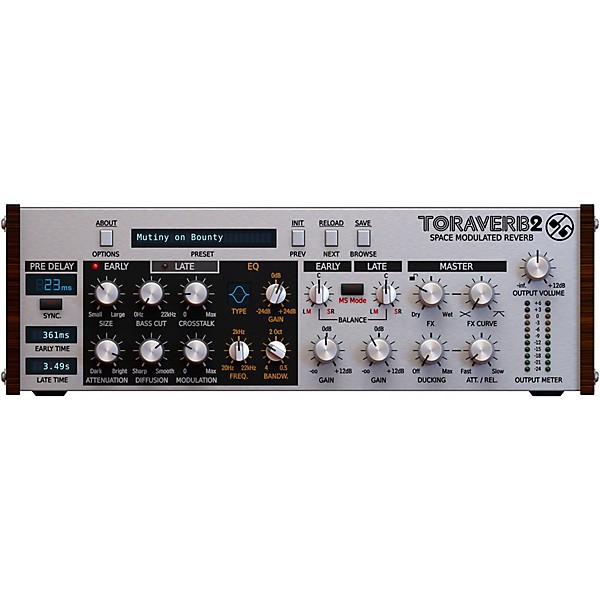Gear SpecialistBundlingMusician
D16 Group Toraverb 2 Space Modulated Reverb (VST/AU) Software Download
(0)|Q&A|Item #:1360601634954 POS #:108926387
6-month special financing^ + $3 back in Rewards** Limited time Learn More
Save on orders $199+ and get expert advice from a Gear Adviser
Need Help?
Description
When D16 Group created Toraverb, they didn't base it on any current reverb unit available in the market or implement any "off-the-shelf" algorithm. Toraverb is not a classic type reverb unit like spring, room, hall or plate. Toraverb is a concept algorithm reverb that uses a set of easily accessible parameters that allow the user to create practically ANY type of reverb.
Critical effect in any studio
Reverb is a critical effect in a mix. Final results depend on the reverb algorithm used and the quality of the implementation. Usually reverb is used as a send effect in which many channels in a mix are routed to it. If a low quality plug-in or hardware unit is used, the end results can sound very disappointing with the reverb tail sounding like it had been "ripped-off" in the mix.
High quality of diffusion
In Toraverb, D16 Group applied diffusing algorithms of the highest possible quality based on modified all-pass filters. By doing this and using properly tuned parameters, Toraverb almost entirely eliminates unwanted flutter echo effects for every sound source.
Separate equalization for early and late reflections
Toraverb is equipped with two independent, single-band, fully parametric equalizers. One is used to EQ early reflections and the other to EQ late reflections. This is an incredibly useful feature, which allows a lot of control over the character of the reverb to give the most natural sound.
Modulated tail
Toraverb also has an additional modulation parameter, which affects the diffusing filters. These are responsible for the distribution of the sound waves reflections in time. By changing the modulation, the sound of the reverb tail can be altered to give a more realistic effect of sound transmission.
Spatial reflections
To give a better impression of physical space, we have added an innovative spatial reflection algorithm to Toraverb. It improves spatial reflections by allowing cross talking of reflected stereo waves between stereo channels. This models what happens in the real world when a sound audible only in the left ear is reflected and is heard in both ears.
Critical effect in any studio
Reverb is a critical effect in a mix. Final results depend on the reverb algorithm used and the quality of the implementation. Usually reverb is used as a send effect in which many channels in a mix are routed to it. If a low quality plug-in or hardware unit is used, the end results can sound very disappointing with the reverb tail sounding like it had been "ripped-off" in the mix.
High quality of diffusion
In Toraverb, D16 Group applied diffusing algorithms of the highest possible quality based on modified all-pass filters. By doing this and using properly tuned parameters, Toraverb almost entirely eliminates unwanted flutter echo effects for every sound source.
Separate equalization for early and late reflections
Toraverb is equipped with two independent, single-band, fully parametric equalizers. One is used to EQ early reflections and the other to EQ late reflections. This is an incredibly useful feature, which allows a lot of control over the character of the reverb to give the most natural sound.
Modulated tail
Toraverb also has an additional modulation parameter, which affects the diffusing filters. These are responsible for the distribution of the sound waves reflections in time. By changing the modulation, the sound of the reverb tail can be altered to give a more realistic effect of sound transmission.
Spatial reflections
To give a better impression of physical space, we have added an innovative spatial reflection algorithm to Toraverb. It improves spatial reflections by allowing cross talking of reflected stereo waves between stereo channels. This models what happens in the real world when a sound audible only in the left ear is reflected and is heard in both ears.
Features
- High quality diffusion network
- Pre-delay with optional tempo sync
- Reverb's tail modulation (with independent control for Early and Late reflections)
- Controllable crosstalk of spatial reflections
- Parametric EQ for Early and Late reflections (with 3 different curves each)
- Early and Late mixer (with stereo balance working in either L/R or M/S domains)
- Built-in ducker
- Adjustable FX crossfade characteristics
- Tag based preset browser
- Two alternative GUI sizes
- MIDI-learn functionality throughout
- 64bit internal processing
Specs
PC
- OS: Windows XP, Windows Vista, Windows 7
- CPU: 2.0 Ghz with SSE (Multicore system 2.4 Ghz recommended)
- RAM: 512 MB (1 GB recommended)
- Software: VST host (32bit or 64bit)
- OS: 10.6.x or 10.7.x
- CPU: Intel based 2.0 Ghz (2.4 Ghz recommended)
- RAM: 512 MB (1 GB recommended)
- Software: AU or VST host (32bit or 64bit)
- Note: This is not a standalone program so you need a host application to use it.




